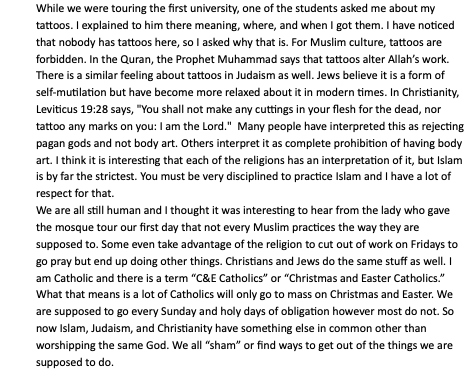Cultural Exchange Through Conquest (Spain and Morocco)
Cultures are a constantly evolving process. They are always changing, spreading, and most importantly, mixing. Before this study abroad started, I was in Portugal and Spain for some time. Every tour I took and historical place I visited didn't fail to mention the effects of the Moorish invasions. In this blog, I am going to explore the effects that these less-than-peaceful exchanges left on the culture while explaining a few examples to explore both the cultures of Spain and Morocco.
First, we are going to start our story with a young Islamic civilization in 711 AD. This civilization is itself a mix of Berbers and Syrians forming the civilization of Al-Andalus (the Moors). They crossed the Strait of Gibraltar and began to conquer Iberia. At this time there were a few Kingdoms that together ruled the Iberian Penisula. These powerful kingdoms banded together to fight off these invaders ... and almost lost. These once powerful kingdoms were pushing into an area one-tenth of their original size. This slow decline took place over the course of several centuries. In the 14th century, the Spanish kings had enough and began the Reconquista, one of the most famous names in history. These Spanish kings rallied and pushed the moors out in only 200 years with the very last piece of land being reclaimed in the late 15th century.
The main idea that needs to be kept in mind with the cultural diffusion of Muslim culture into Spain is time. It may seem that the gothic Kingdoms of Spain was technically a continuous presence, but it must be noted that the southernmost tip of the Iberian Peninsula was under Moorish control for around 800 years. That is more than twice as long as the U.S. has existed. During my travels in Portugal and Spain, I saw many Muslim influences. The most notable was in the architecture. Tiles were a prevalent sight in many cities that I visited. These tiles are a hallmark of Muslim civilizations. Furthermore, most buildings and public places had an architecture that featured large stunning archways that are specific to the Moors. Another facet of mixing cultures is one that I have found growing in importance, language. There are many Arabic influences in the Spanish language. One such example is the verb ojala which in Spanish essentially means to hope that something happens. This is almost directly taken from the Arabic inshalla which means god willing. I have been finding that using a language that someone is familiar with, or at least trying is one of the fastest ways to connect with someone. I have been practicing my Spanish with people, and they are often very happy that I am trying to learn their language. Furthermore, I have been feeling much more relaxed as soon as someone here in Morocco speaks English. This is all to say that I think that language is one of the major pillars of culture, and a blending of languages shows an extremely strong exchange of culture.
It is not only an Arabic influence on Spain but vice versa as well. I'd like to say that the Spanish culture peacefully diffused backward while they were under Moorish rule, but that is not the case. As I'm sure some Spanish king said at some point, "Once the Reconquista starts, it doesn't stop". The Spanish continued pushing into much of northern Morocco through the Strait. While this was going on, the Portuguese were also attacking the coast. Both invasions were somewhat successful, but the Spanish were much more successful. This led to Spanish being spoken in the northern part of Morocco, and many Spanish influences in the area.
As we have moved north through Morocco, I have been seeing more effects of this less-than-peaceful exchange of cultures.
Fuchs, B., & Liang, Y. (2011). A FORGOTTEN EMPIRE: THE SPANISH-NORTH AFRICAN BORDERLANDS. Journal of Spanish Cultural Studies, 12(3), 261–273. https://doi.org/10.1080/14636204.2011.658695
Standard-Times, M. a. S. C. N. B. (2011, January 12). Muslim Moors left their stamp on the civilization of Spain. Standard-Times. https://www.southcoasttoday.com/story/news/nation-world/2002/01/06/muslim-moors-left-their-stamp/50295902007/
The Moors in Andalucia - Spain’s Moorish History | Andalucia.com. (2022, December 7). Andalucia.com. https://www.andalucia.com/history/spainsmoorishhistory.htm#:~:text=The%20Moors%20ruled%20parts%20of,Mezquita%20%E2%80%93%20dating%20from%20Moorish%20times.
Wikipedia contributors. (2023). Moors. Wikipedia. https://en.wikipedia.org/wiki/Moors




Henry, I think we have shared some observations during our time in Spain and here in Morocco. I had the opportunity to study abroad in Spain in 2019. I noticed the influence of Moorish and Muslim control in the architecture too. The wide array of cultural influences was particularly prevalent in Grenada, Spain when we toured the Alhambra, an ancient palace.
ReplyDeleteI also recognize the relationship between language and culture. My first-year odyssey course at UGA was focused on linguistics and endangered languages. I learned that language played a critical role in how the people who speak it make meaning of the world around them. We may feel more comfortable when people speak the same language as us because we believe they make meaning of the world in similar ways as we do. Being in a country where so many languages are prevalent is evidence of the culmination of cultures in Morocco. I believe that there are many ways people make meaning of the world around them in Morocco. This is one aspect of the country that has drawn me in the most.